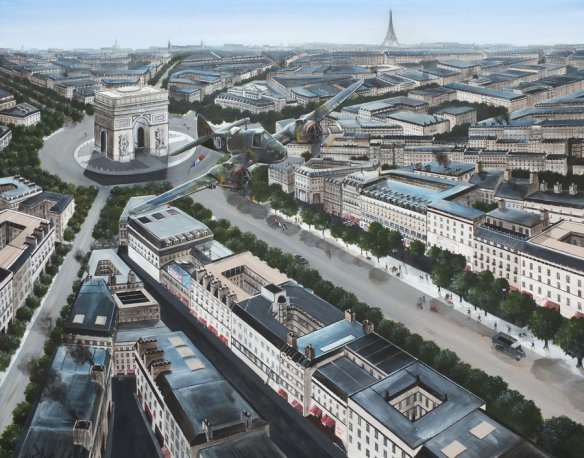
Operation Squabble by eskiwoods
Alfred ‘Ken’ Gatward, the daring RAF pilot who dropped the French Tri-Colour on occupied Paris as part of the WWII Operation Squabble during the spring of 1942.
This was a special operation in the Paris area carried out in June 1942 which was intended to create a heartening effect among the Parisians and to expose the occupying Germans to ridicule.
From information obtained from a reliable source it appeared that the enemy performed a routine parade along the Avenue des Champs Elysee every day between the hours of 1215 and 1245, and it was considered by the Air Ministry that a low flying machine gun and cannon attack launched against this parade would have most valuable results in upholding the moral of the French people.
As the target was outside the range of Spitfires and all Fighter Command’s Beaufighters were fitted with special equipment, it was decided by the Air Ministry on 30 April 1942 that the operation should be undertaken by a Coastal Command Beaufighter
Accordingly the A.O.C-in-C was requested to make arrangements for this attack to be delivered at his discretion. This special flight was allocated the name “Operation Squabble” and No. 236 Squadron was chosen to fulfil the task.
The hazardous nature of this operation called for specific conditions of cloud cover over certain parts of the route which did not materialise until 12 June 1942, after four previous attempts had been made abortive by the lack of cloud cover on crossing the French coast.
On this day, however, conditions appeared to be more satisfactory, so, Beaufighter C/236 Squadron with F/Lt. A K. Gatward as pilot and Sgt. G F. Fern as navigator, was airborne at 1129 hours from Thorney Island on “Operation Squabble”.
In conditions of ten tenths cloud at 2,000 feet with heavy precipitation the aircraft set course for the target at 1131 hours. Crossing the French coast a few miles eastward of Fecamp at 1158 hours, the cloud began to thin out and by the time Rouen was reached there was bright sunshine. With visibility at ten to twenty miles and no cloud, the aircraft passed over the suburbs of Paris at a very low altitude and some light flak was encountered for the first time. The Eiffel Tower was easily pinpointed and was circled at 1227 hours.
There was, unfortunately, no sign of the parade, but to compensate for this development a Tricolour was successfully dropped over the Arc de Triomphe, after which the aircraft flew down between the buildings of the Champs Elysee but there was still no sign of any troops. In accordance with briefing instructions the pilot then proceeded to attack with cannon fire the Ministry of Marine building and released a second Tricolour.
The pilot reported that there were plenty of people about of both sexes, with most of them in shirt sleeves, many of whom waved. Before opening fire on the Ministry of Marine building, however, the pilot ensured that there were no pedestrians in the line of fire. His point of aim was half-way up the building.
At 1230 hours the aircraft set course for base and maintained the same track back to the coast as followed on the outward flight. The French coat was crossed for the second time at 1255 hours and the aircraft finally landed at Northolt at 1353 hours.
The whole sortie had been flown at a height of twenty to thirty feet and although the aircraft flew over Rouen aerodrome at this altitude no enemy opposition was encountered. The light flak encountered over the target was very poor.
This mission received its full share of publicity and some of the photographs en route were released to the general public. In addition, the pilot of the aircraft, F/Lt. A K. Gatward was awarded the DFC and the navigator Sgt. G F. Fern was granted a commission.
AIR 41/47